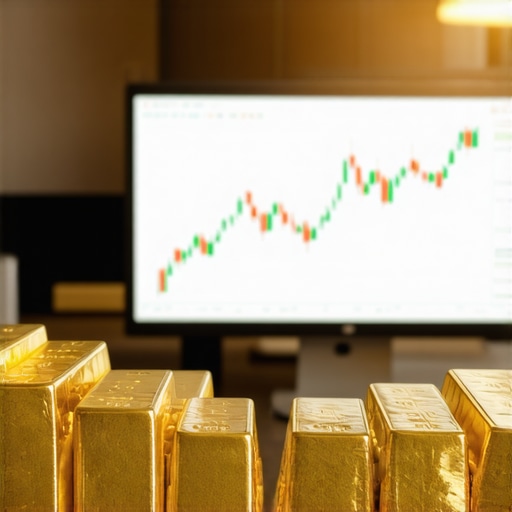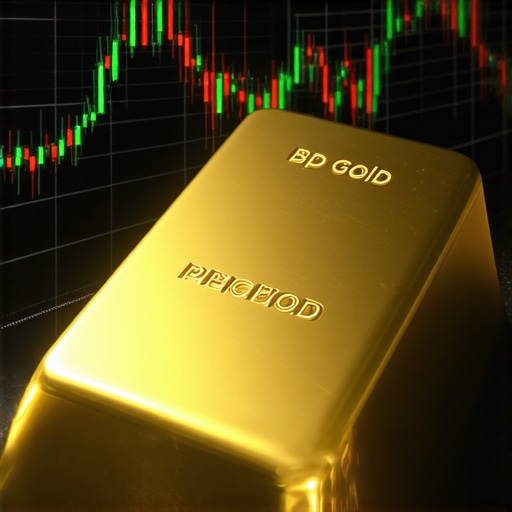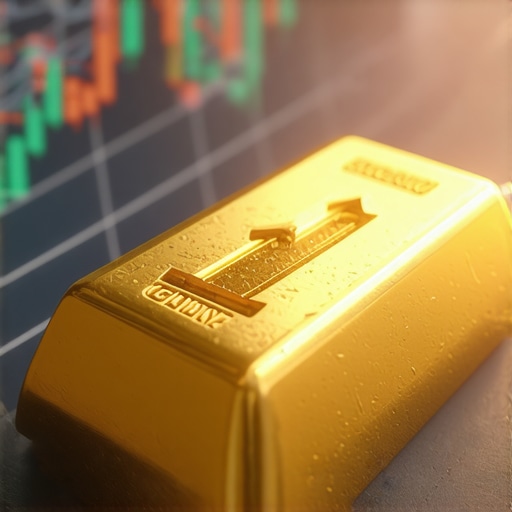Understanding the Influence of Economic Shifts on Gold Prices
The global economy is a complex web of interrelated factors that can significantly impact financial markets, including the price of gold. As an investor, understanding how economic shifts affect gold prices is crucial for making informed decisions. Gold has long been viewed as a safe haven during times of economic uncertainty, and its value tends to fluctuate based on various economic indicators.
The Role of Inflation in Gold Pricing
One of the primary economic factors influencing gold prices is inflation. When inflation rates rise, the purchasing power of currency decreases. This scenario often leads investors to seek gold as a hedge against inflation, driving up its price. Historically, periods of high inflation correlate with increased gold demand, as investors look to protect their wealth.
Impact of Interest Rates on Gold Demand
Interest rates also play a significant role in determining gold prices. Lower interest rates tend to reduce the opportunity cost of holding non-yielding assets like gold, making it more attractive to investors. Conversely, when interest rates rise, the attractiveness of gold diminishes as investors prefer interest-bearing assets. This inverse relationship highlights the importance of monitoring interest rate trends in the context of gold investments.
Geopolitical Events and Gold Market Reactions
Economic shifts are often accompanied by geopolitical events that can create volatility in the financial markets. Global tensions, trade disputes, and political instability can lead to increased demand for gold. Investors often flock to gold during uncertain times, viewing it as a stable investment. For instance, during the recent geopolitical tensions, gold prices surged as investors sought refuge from potential market disruptions.
Understanding Supply and Demand Dynamics
The fundamentals of supply and demand also significantly influence gold prices. When the demand for gold rises, particularly in countries with strong purchasing power like China and India, prices tend to increase. Similarly, any disruptions in gold mining operations or supply chains can lead to scarcity, further driving up prices. Investors should stay informed about the global supply chain dynamics to better anticipate price movements.
Future Predictions for Gold Prices
Looking ahead, the future of gold prices will likely be shaped by ongoing economic shifts. Factors such as central bank policies, global economic recovery post-pandemic, and evolving investor sentiment will play pivotal roles. As central banks continue to monitor inflation and adjust interest rates, gold investors must stay vigilant and adaptable to navigate these changes effectively.
For those considering entering the gold market, understanding these economic indicators is vital. By keeping an eye on inflation trends, interest rates, geopolitical developments, and supply-demand dynamics, investors can make more informed choices in their gold investments. For more insights on gold market trends, explore our article on Understanding Investor Behavior in the Gold Market.
Exploring Gold Demand Trends in 2025
As we delve deeper into the dynamics of the gold market, understanding the trends that drive demand in 2025 becomes essential. The interplay between economic factors and gold prices highlights the necessity for investors to remain informed and proactive. By analyzing key trends, investors can strategically position themselves to capitalize on potential opportunities.
Shifts in Consumer Behavior Towards Gold Investments
In recent years, there has been a notable shift in consumer behavior towards gold investments. With increasing awareness of gold’s role as a hedge against inflation and economic uncertainty, more individuals are considering gold as a viable investment option. This trend is particularly evident among younger investors who are prioritizing gold in their portfolios. As more individuals seek to diversify their investments, the demand for gold is expected to rise significantly in 2025.
The Rise of Digital Gold and Its Market Implications
Another significant trend shaping the gold market is the rise of digital gold investment options. With the advent of technology, more platforms are facilitating gold investments through digital assets, such as gold-backed cryptocurrencies and fractional gold ownership. This innovation is making gold more accessible to a broader audience, potentially increasing overall demand. Investors should consider how these digital options might influence traditional gold markets and pricing strategies.
Global Economic Recovery and Its Influence on Gold Prices
The global economic recovery post-pandemic will undoubtedly impact gold prices. As economies rebound, various sectors will experience growth, leading to shifts in gold demand. For instance, a resurgence in industrial demand for gold, driven by electronics and renewable energy sectors, may contribute to upward price pressure. Investors must keep an eye on these developments to anticipate the future trajectory of gold prices. For more insights on these trends, check out our article on Current Trends Driving Gold Demand in 2025.
The Influence of Central Bank Policies on Gold Investments
Central bank policies are another crucial factor influencing gold prices. As central banks adjust their monetary policies in response to inflationary pressures and economic growth, their gold purchasing strategies can significantly impact market dynamics. Increased central bank purchases of gold can signal confidence in the asset, driving demand and prices higher. Investors should monitor these policy changes closely, as they can provide valuable insights into future gold market trends.
Understanding Investor Sentiment and Market Psychology
Investor sentiment plays a vital role in shaping gold prices. Market psychology can lead to fluctuations in demand based on traders’ perceptions of economic stability. During times of uncertainty, heightened fears often lead to increased gold purchases. Conversely, periods of economic optimism can result in diminished demand as investors shift towards higher-risk assets. By understanding these psychological factors, investors can make more informed decisions about when to enter or exit the gold market.
In conclusion, the interplay between economic factors and gold prices highlights the importance of being well-informed in today’s dynamic market. By recognizing trends in consumer behavior, the rise of digital gold, and the implications of central bank policies, investors can better navigate the complexities of gold investments. For further reading on how to assess your gold investment portfolio, explore our guide on Evaluating Your Gold Investment Portfolio: Best Practices.
Factors Influencing Gold Demand in 2025
As we explore deeper into the gold market dynamics, it is crucial to understand the multifaceted factors influencing gold demand in 2025. These factors encompass not only economic conditions but also technological advancements and evolving investment strategies. By comprehensively analyzing these elements, investors can position themselves strategically to take advantage of potential market shifts.
The Impact of Inflation on Gold Investments
Inflation remains a significant driver of gold demand. Historically, gold has been viewed as a safe haven during inflationary periods, as it tends to retain its value better than fiat currencies. In 2025, as inflation concerns persist, more investors may turn to gold to hedge their portfolios against diminishing purchasing power. This trend underscores the importance of understanding gold as an inflation hedge and recognizing its role in wealth preservation amidst economic fluctuations.
Technological Innovations in Gold Trading
The evolution of technology continues to reshape the investment landscape, particularly in gold trading. Innovations such as blockchain technology and mobile trading platforms are making gold investments more accessible and secure for investors. These advancements facilitate real-time transactions and the ability to own fractional shares of gold, attracting a new generation of investors. For those interested in exploring these technological advancements, our article on different types of gold investments provides valuable insights.
Geopolitical Factors and Their Effect on Gold Prices
Geopolitical tensions often lead to increased volatility in financial markets, thus impacting gold prices. Events such as trade disputes, military conflicts, and political instability can cause investors to seek the security of gold. Understanding how these geopolitical factors play into market dynamics is essential for investors looking to navigate the complexities of gold investments. For a deeper dive into this subject, check out our analysis on the impacts of geopolitical events on gold prices.
Long-Term Trends in Gold Demand
Long-term trends suggest a sustained increase in gold demand due to various factors, including the growing middle class in emerging markets and the rising popularity of gold investments among millennials. This demographic shift is expected to drive significant changes in investment strategies, with more emphasis on sustainable and ethical investing practices. Investors should consider how these long-term trends may shape the future of gold demand and the investment landscape.
Strategic Insights for Gold Investors
For investors looking to capitalize on gold demand trends in 2025, it is essential to adopt a well-rounded investment strategy. Diversifying one’s investment portfolio by including various forms of gold, such as physical gold, ETFs, and mining stocks, can mitigate risks and enhance potential returns. For more on how to develop a robust investment strategy, refer to our article on top gold investment strategies for the next decade.
In summary, understanding the intricate factors influencing gold demand in 2025 is vital for making informed investment decisions. By staying abreast of inflation trends, technological advancements, geopolitical events, and long-term market shifts, investors can effectively navigate the evolving gold landscape and seize opportunities for growth.
Understanding Global Economic Influences on Gold Demand
The global economy is a significant driver of gold demand, influencing investment trends and market behavior. As countries grapple with economic recovery post-pandemic, fluctuations in currency values and interest rates will likely impact gold prices. Investors should remain vigilant about these economic indicators, as they can provide insights into when to buy or sell gold. For a comprehensive look at how these dynamics play out, our article on understanding investor behavior is a valuable resource.
The Role of Central Banks in Gold Market Dynamics
Central banks play a pivotal role in shaping gold demand through their purchasing behaviors. In recent years, many central banks have increased their gold reserves as a hedge against economic uncertainty. This trend is expected to continue in 2025, potentially leading to increased demand for gold. Understanding the motivations behind central bank purchases can provide investors with critical insights into market trends. For more information on this topic, refer to our piece on central bank gold purchases.
Emerging Markets and Their Growing Appetite for Gold
Emerging markets, particularly in Asia, are witnessing a surge in gold demand as economic growth accelerates and disposable incomes rise. Countries such as India and China are significant players in the gold market, with cultural factors driving high levels of gold consumption. Investors should keep an eye on these markets, as their demand fluctuations can greatly influence global gold prices. For insights into how these emerging trends affect investments, explore our article on current trends driving gold demand.
Investment Strategies for a Volatile Gold Market
Given the volatility of the gold market, developing a robust investment strategy is essential for success. Investors should consider diversifying their portfolios by incorporating a mix of physical gold, ETFs, and mining stocks. Each investment type offers unique advantages and risks. For instance, owning physical gold can provide a tangible asset, while ETFs offer liquidity and ease of trading. To learn more about effective strategies, check out our guide on investing in gold ETFs.
Risk Management in Gold Investments
Risk management is crucial when investing in gold. By understanding the factors that contribute to market fluctuations, investors can make informed decisions to mitigate risks. Utilizing tools such as stop-loss orders and setting clear investment goals can safeguard against unexpected market movements. For further guidance on managing your gold investments, consider reading our article on evaluating your gold investment portfolio.
Staying Informed: The Importance of Continuous Learning
The gold market is constantly evolving, necessitating that investors stay informed about new trends, technological advancements, and geopolitical developments. Engaging with educational resources and market analysis can empower investors to make well-informed decisions. For ongoing insights, be sure to revisit our content on gold market analysis regularly.
In conclusion, navigating the complexities of gold investments requires a keen understanding of various influencing factors. By staying informed about global economic shifts, central bank activities, and emerging market trends, investors can position themselves to capitalize on opportunities in the gold market for 2025 and beyond.
Comprehensive FAQ Section on Gold Investments
What factors influence gold prices?
Gold prices are influenced by various factors, including global economic conditions, currency fluctuations, central bank policies, and geopolitical events. Supply and demand dynamics also play a crucial role, as do trends in investment behaviors and market sentiment.
How can I start investing in gold?
To start investing in gold, you can consider various options such as purchasing physical gold (jewelry, coins, bars), investing in gold exchange-traded funds (ETFs), or buying shares in gold mining companies. Each method has its advantages and risks, so it’s essential to research and choose the best fit for your investment strategy.
Is gold a safe-haven investment?
Yes, gold is often considered a safe-haven investment, especially during economic uncertainty or market volatility. Investors tend to flock to gold when other investments may be underperforming, as it traditionally retains its value.
What are gold ETFs, and how do they work?
Gold ETFs are investment funds that track the price of gold and are traded on stock exchanges. They allow investors to gain exposure to gold without having to physically hold the metal. Investors buy shares of the ETF, which holds gold bullion or gold-related assets, making it a convenient option for many.
What are the risks of investing in gold?
Investing in gold carries certain risks, including price volatility, lack of income generation (unlike stocks or bonds), and the potential for market manipulation. Additionally, physical gold can incur storage and insurance costs. Understanding these risks is crucial for making informed investment decisions.
How do geopolitical events impact gold prices?
Geopolitical events, such as conflicts, elections, and economic sanctions, can create uncertainty in financial markets. This uncertainty often drives investors to gold as a safe-haven asset, leading to increased demand and higher prices.
Can I invest in gold through retirement accounts?
Yes, you can invest in gold through retirement accounts, such as a Self-Directed IRA. This allows you to hold physical gold or gold-related investments within your retirement portfolio, potentially benefiting from tax advantages.
What is the best time to invest in gold?
The best time to invest in gold can vary based on market conditions, economic indicators, and personal financial goals. Generally, many investors consider buying during market downturns or when economic uncertainty is high, as gold often performs well during these periods.
Authority Resources for Gold Investment Insights
For further exploration of gold investments and market insights, consider the following trusted resources:
- World Gold Council – Provides comprehensive data and reports on the gold market.
- Investing.com – Offers real-time market data, news, and analysis on gold and other commodities.
- Kitco News – Features live gold prices, expert commentary, and market analysis.
- Bloomberg – Delivers financial news and analysis, including insights on gold investments.
- MarketWatch – Offers the latest news and trends affecting the gold market.
In conclusion, navigating the complexities of gold investments requires a keen understanding of various influencing factors. By staying informed about global economic shifts, central bank activities, and emerging market trends, investors can position themselves to capitalize on opportunities in the gold market for 2025 and beyond. Engaging with educational resources and trusted authorities can further enhance your investment strategies and decision-making processes.











It’s fascinating to see how intertwined economic indicators are with gold prices, especially the role of inflation and interest rates. From my experience, the inverse relationship between interest rates and gold can sometimes be overshadowed by sudden geopolitical events, which tend to cause rapid spikes in gold demand regardless of the current rate environment. For example, during periods of unexpected conflict or political unrest, gold often becomes the go-to safe haven even if interest rates are relatively high at that time. I’ve also noticed how supply chain issues can quietly push prices up when mining disruptions occur, a factor that doesn’t always get the spotlight but has a tangible impact. Given all these variables, I wonder how investors balance these often competing influences when deciding the right time to enter or exit the gold market. How do others weigh inflation fears against central bank policies or geopolitical risks when shaping their gold investment strategies? Are there particular indicators you’ve found more reliable for predicting price movements in such a volatile environment?